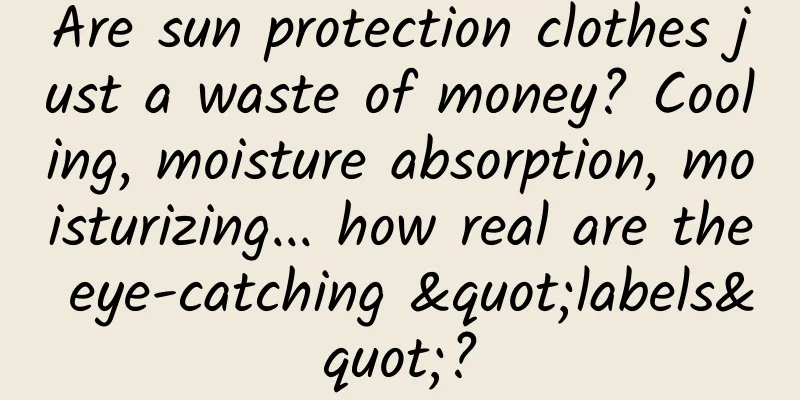Are sun protection clothes just a waste of money? Cooling, moisture absorption, moisturizing... how real are the eye-catching "labels"?

|
The sun is scorching, the sun is burning the earth, burning with the air, the burning feeling gradually spreads Some netizens joked: In the recent weather, the cold dishes in my hand were inadvertently dried into spicy hot pot. Faced with the extremely hot weather, sun protection has become a "compulsory course" for everyone. Image source: Visual China In addition to traditional sun protection methods such as applying sunscreen and using parasols, sun protection clothing has gradually become popular in recent years and has become a favorite of many people. However, UPF50+, cooling feeling, hyaluronic acid moisturizing... the various selling points of sun protection clothing often make people dazzled. What basic conditions should sun-protective clothing meet? Can these advertised selling points of sun-protective clothing really be achieved? As a consumer, how should you choose? Regarding these consumers' questions, the reporter interviewed Liu Xiuming, associate professor of the Light Chemical Engineering Department, School of Textile Science and Engineering, Tianjin Polytechnic University, to answer everyone's questions. What basic indicators should sun-protective clothing meet? To determine whether a piece of clothing meets the standards for sun protection clothing, you need to pay attention to two basic indicators: UV protection factor and UV transmittance. my country's national standard GB/T 18830-2009 "Evaluation of the UV Protection Performance of Textiles" stipulates that textiles with an ultraviolet protection factor (UPF) greater than 40 and an ultraviolet transmittance (UVA) of less than 5% at 315-400nm can be called "UV protection products." Image source: Guangming Daily As an important indicator to measure the sun protection effect of sun protection clothing, the UPF value has always been a key point that merchants pay close attention to. We can often see the UPF50+ mark on the product cover pictures on e-commerce platforms. In fact, when 40<UPF≤50, it will be marked as UPF40+; when UPF>50, it will be marked as UPF50+, which is the highest evaluation level in the national standard. Why can sun-protective clothing protect against the sun? In response to this question, Liu Xiuming introduced that sun-protective clothing mainly ensures sun protection through two ways. One is to add UV shielding agents to the fabric to prevent UV rays from transmitting and avoid UV rays from reaching the skin; the other is to add UV absorbers to absorb UV rays and prevent them from reaching the skin. Schematic diagram of the basic principles of two sun protection methods: shielding and absorption of anti-ultraviolet fabrics (picture provided by the interviewed experts) The parasols we commonly use use the UV shielding mechanism, while sunscreen cosmetics mostly use the UV absorption mechanism. In comparison, the long-term performance and comfort of sunscreen clothing made by UV absorption will be relatively higher, and the cost is also higher than that of UV shielding. Can sun-protective clothing really provide a cool feeling and reduce temperature? In the hot summer, many sun protection clothes are marketed as cool and cooling clothes. Some even claim that the sun protection clothes are made of xylitol ice oxygen, which can dissipate heat in one second and reduce 5℃. Can this really be done? On June 3, 2024, Beijing welcomed sunny and hot weather. The picture shows tourists wearing sun-protective clothing. Image source: Visual China In fact, perhaps many buyers have also experienced that this feeling of coolness and cooling only lasts for a very short time. It feels very good when you first put it on, but as long as you stay outdoors for a short while, this beauty will disappear. From a scientific point of view, this cool feeling should be called "coolness upon contact." Liu Xiuming explained that in order to achieve this instant cool feeling, many manufacturers will add some materials that improve the thermal conductivity of the fiber during spinning, thereby increasing the body's conduction heat dissipation. When the skin touches the clothing, the fabric can quickly transfer heat and the skin will feel cool. Xylitol, as a five-carbon sugar alcohol, is an intermediate product of xylose metabolism. The reason why it has a cool feeling is that xylitol is easily soluble in water and absorbs a certain amount of heat when dissolved. Therefore, introducing xylitol into the fiber can also give users a cool feeling. However, because it is soluble in water, this effective ingredient will gradually disappear after washing several times, and the refreshing feeling will be greatly reduced. When hyaluronic acid meets sun protection clothing, can it really moisturize the skin? In recent years, as people pay more and more attention to health, skin health has gradually attracted people's attention. In the sunny and dry summer, everyone wants to hydrate their skin. Therefore, some manufacturers have incorporated the concept of hyaluronic acid into clothing production, claiming that 762mg/kg hyaluronic acid is added during the production process. When people wear it, the hyaluronic acid will be released, which is equivalent to applying a layer of mask, which can moisturize the skin. In fact, the moisturizing ability of this mask sunscreen clothing is very small and can be basically ignored. On the one hand, the proportion of hyaluronic acid added is extremely low, far from the concentration of hyaluronic acid used in the medical beauty industry. On the other hand, sun protection clothing is not tight clothing, and there is still space between it and the skin after wearing it, so the effect is even less. How to choose sun-protective clothing scientifically and reasonably? The scorching weather has gradually increased everyone's expectations for sun protection clothing, hoping that it will have better functionality, good sun protection and breathability, and good moisture absorption and perspiration. Given that there are currently no targeted standards for sun protection clothing, it is recommended that everyone first pay attention to its basic sun protection function and choose products with UPF>40 and UVA<5%. On this basis, we need to realize that the sun protection effect of sun protection clothing is related to many factors such as the type of fiber material of the textile, the depth of color, the tightness of the weaving structure, and the thickness of the fabric. Focusing on these key factors, Liu Xiuming further gave purchasing suggestions: Among natural fibers, flax has the best sun protection effect; among chemical fibers, polyester has a better sun protection effect. Dark-colored sun-protective clothing is more effective than light-colored ones. You can choose based on your own preferences. The denser the weaving structure, the thicker it is, and the lower the porosity, the better the sun protection effect. Source: Beijing Science and Technology News Author: Liao Mailun |
>>: Don't squeeze a pinhole! Here's how to deal with it correctly
Recommend
How to write the Double 12 event plan? This universal solution is for you!
It feels like everyone is busy and exhausted from...
Dislocated joints due to yawning, broken bones due to going to toilet, why are contemporary college students so "fragile"?
Audit expert: Wu Xinsheng Deputy Chief Physician ...
Alipay Mini Program is here! This may be Alibaba’s most important strategy after Jack Ma announced his resignation!
[[243459]] There is a saying in the Internet indu...
Taobao weight loss: What is website over-optimization? How can SEO prevent over-optimization?
The basic meaning of seo is search engine optimiz...
Low Earth orbit space is a "big treasure"
Not long ago, after the successful launch of the ...
Product Operations | The only difference between you and a product manager is experience and a business card!
The internal war between operations and products ...
How to replicate the success of Jiang Xiaobai and Heytea?
Brand marketing is a discipline that combines sci...
The 3rd Taobao Violence Project Course Video of Drainage Brother
1. Project Introduction When you buy things on Ta...
Loopy, the new "top streamer" of emojis, still has to act according to the mood of the river in real life...
Recently, Loopy from the Korean animation "P...
Understand these 8 questions before competing with Tmall marketing IP
A complete and qualified Tmall marketing IP plan ...
The United States announced the cancellation of Hong Kong’s special treatment! What impacts will it have? Attach details
As the epidemic changes, new problems have also e...
Is it cheap to rent a BGP server room?
Is it cheap to rent a BGP server room? The BGP co...
Analysis of McDonald’s marketing code!
"Would you like some cilantro with ice cream...
The video of "katydid spinning silk and weaving a web" has gone viral! But it's not actually a katydid, it's also related to Ultraman...
There is a video that has gone viral online recen...
What are the functions of Huizhou WeChat Beauty Mini Program? How much does it cost to develop a skin care product mini program?
The most profitable industry nowadays is the &quo...









